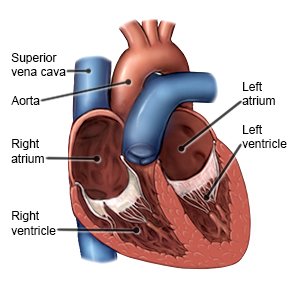Watchman Implant
Medically reviewed by Drugs.com. Last updated on Apr 6, 2025.
What do I need to know about the Watchman® implant?
The Watchman implant is a permanent heart device. The implant is designed to prevent blood clots caused by atrial fibrillation (A-fib) from getting into the bloodstream. A-fib prevents the heart from pumping blood correctly. Blood that is not pumped out may pool in a part of the heart called the left atrial appendage. Blood clots may form in the pooled blood. If a clot moves out of the appendage and into the bloodstream, it can cause a stroke. The implant closes off the appendage to prevent clots from moving into the bloodstream. This helps lower your risk for a stroke.
 |
How do I prepare for the implant to be placed?
- Your healthcare provider will tell you how to prepare for the procedure. He or she may tell you not to eat or drink anything after midnight on the day of the procedure. Arrange to have someone drive you home after you are discharged.
- Your provider will use a type of CT scan to check your atrial appendage for clots. The size, shape, and exact location of your atrial appendage will also be checked.
- You may need blood tests or scans of your leg and heart veins. You will be checked heart or carotid artery problems. Certain problems will prevent you from being able to get the implant.
Drugs used to treat this and similar conditions
Xarelto
Xarelto (rivaroxaban) is a factor Xa inhibitor used to reduce the risk of blood clots and stroke in ...
Multaq
Multaq (dronedarone) is an antiarrhythmic medication used to treat atrial fibrillation and atrial ...
Omvoh
Omvoh is used to treat moderate to severe ulcerative colitis or Crohn's disease in adults. This ...
Coreg
Coreg (carvedilol) is used to treat heart failure and hypertension (high blood pressure). Includes ...
Rivaroxaban
Rivaroxaban systemic is used for atrial fibrillation, cardiovascular risk reduction, congenital ...
Propafenone
Propafenone systemic is used for atrial fibrillation, atrial flutter, ventricular tachycardia ...
Sotalol
Sotalol is a beta-blocker with antiarrhythmic properties that affects the heart and circulation ...
Carvedilol
Carvedilol (Coreg) is used to treat heart failure and hypertension (high blood pressure). Includes ...
Flecainide
Flecainide systemic is used for atrial fibrillation, atrial flutter, paroxysmal supraventricular ...
What will happen during the procedure?
- General anesthesia is usually used. General anesthesia will keep you asleep and free from pain. Your surgeon will insert a catheter (thin tube) into a vein in your leg. He or she will move the catheter up and into the left atrial appendage.
- The catheter will be removed. The device will be pushed through the catheter and into the appendage. As it comes out of the catheter, the implant will open like a parachute. It will fill the opening of the appendage. Over time, heart tissue will grow over the implant. This seals the opening so clots cannot come out of the appendage.
- The catheter will be removed from the vein in your leg. The site will be covered with a bandage. Pressure may be applied to help stop any bleeding. You will then be taken to a room to be monitored for any problems. When healthcare providers see you are okay, you will be taken to a hospital room.
What should I expect after the procedure?
- You may stay in the hospital overnight after the procedure. You may be able to go home the next day. Your healthcare provider will tell you if you need to stay longer for more monitoring.
- You may have a bruise or swelling where the catheter went into your skin. The area may be sore or tender. These symptoms are normal and should go away in a few days.
- You will need to take blood thinning medicine until heart tissue grows over the implant. This usually takes about 6 weeks.
- Your healthcare provider will use a transesophageal echocardiogram (TEE) about 45 days after the procedure. The TEE will show any gaps around the implant. It will also show any blood clots that may have formed because of the implant.
What are the risks of the Watchman implant?
Your heart may be punctured during the procedure. You may have an air embolism (air or bubbles block a blood vessel). An air embolism can cause a stroke. The device may cause a clot to form and move into your bloodstream. The device may not cover the whole atrial appendage. A gap can allow blood clots to leave the atrial appendage and move into your bloodstream. It may take longer than expected for your body to heal over the device. You may have an allergic reaction to the implant. Your heart may develop an irregular rhythm. You may develop a fistula (abnormal opening between 2 areas). You may bleed more than expected or have brain, groin, or stomach bleeding. Your blood pressure may drop too low. You may develop an infection or pneumonia.
Care Agreement
You have the right to help plan your care. Learn about your health condition and how it may be treated. Discuss treatment options with your healthcare providers to decide what care you want to receive. You always have the right to refuse treatment. The above information is an educational aid only. It is not intended as medical advice for individual conditions or treatments. Talk to your doctor, nurse or pharmacist before following any medical regimen to see if it is safe and effective for you.© Copyright Merative 2025 Information is for End User's use only and may not be sold, redistributed or otherwise used for commercial purposes.
Further information
Always consult your healthcare provider to ensure the information displayed on this page applies to your personal circumstances.
